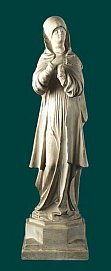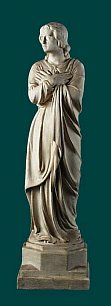Nuremberg Madonna and John


The so-called Nuremberg Madonna remained - although she was created as long ago as 1515/1520 by an unknown Nuremberg carver - unnoticed until the 19th century. Then, however, the earned a prestige not granted to many pieces of art. Firstly, Albert Reindl, director of the Nuremberg arts and crafts school, published a copperplate in 1829, and the figure became well-known in Nuremberg. Gustav Friedrich Waagen, who had been director of the gallery of the New Museum in Berlin since 1832, saw the local celebrity on a research trip to Franken and described her in notes published in 1843. In 1842 an original-size (150 cm) cast and in the 1840s a reduced copy (45 cm) were made. So the figure became known outside Nuremberg around the middle of the 19th century. Because of the assumption that the Nuremberg Madonna would have been created as part of a crucifixion group, Bernhard Afinger has supplemented Maria with an invented john and manufactured both in the size of the reduction copy, perhaps as a reaction to the popularity of the figure. Both figures are preserved in the collection in Halle. Although the two casts were common after the middle of the 19th century, no other copies are known of today. But why was the figure so popular? The answer usually given is the unique conception of the piece, i.e. the fact that a Mater Dolorosa appears here like a girl who is not grieving. For Albert Reindl, however, its appeal was primarily the similarity in style to the highly esteemed apostles of the Sebaldusgrab.




